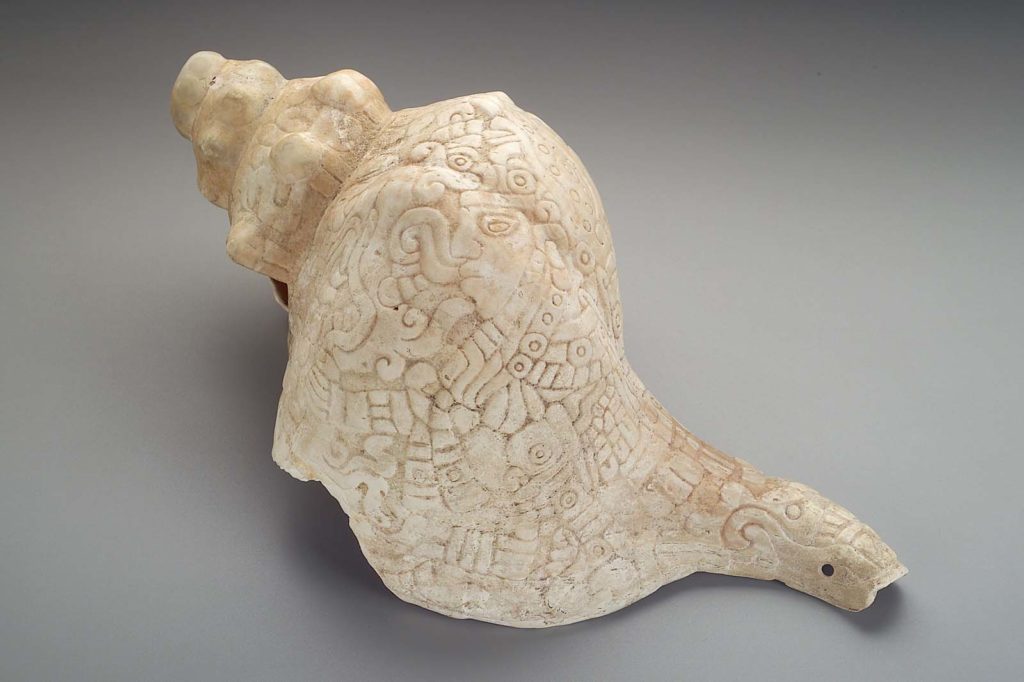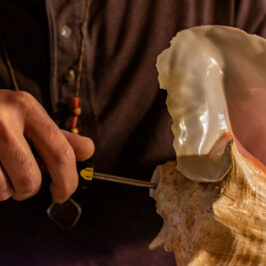The conch shell trumpet, a seemingly simple instrument carved from nature’s bounty, boasts a rich and fascinating history. From the ancient shores of the Pacific to the bustling ports of the Caribbean, these resonating shells have served as a powerful tool for communication, a sacred instrument in rituals, and a source of vibrant musical expression across diverse cultures.
A Natural Wonder Takes Shape:
The conch shell trumpet, also known as a conch shell horn or seashell horn, utilizes the natural spiral shape of the conch shell to create a resonant chamber. Modifications are minimal, often limited to smoothing the aperture (opening) and sometimes adding a mouthpiece made of wood, shell, or other materials. This simplicity, however, belies the instrument’s profound impact on human societies.

Echoes of Communication:
Across vast distances, the booming sound of the conch shell trumpet served as a vital tool for communication. In the Polynesian islands, the pu (pronounced poo) signaled the arrival of canoes, called gatherings, and even issued warnings of danger. Similarly, the hora or pū (pronounced poo) of New Zealand echoed through Maori communities, conveying messages and announcements. The alelu of Hawaii, often decorated with intricate carvings, served as a chiefly symbol and a means of communication for royalty.
A Call to Ceremony:
The conch shell trumpet’s deep, resonant sound transcended mere communication, becoming a sacred instrument in many cultures. In Hindu traditions, the shankha (pronounced shunk-ha) is a revered object associated with the god Vishnu. Its sound is believed to be auspicious and is used in religious ceremonies, pujas (ritual worship), and meditation practices. Similarly, in Buddhist rituals of Tibet and Japan, the dung-dkar (Tibetan) or horagai (Japanese) is played to summon monks and announce religious events. The Aztecs of Mesoamerica utilized the teponaztli (pronounced tep-o-nazt-li), a conch shell trumpet with a slit carved on the side, to accompany rituals and ceremonies.

The Rhythm of Celebration:
The conch shell trumpet wasn’t solely confined to the realm of the sacred. Its vibrant melodies also resonated in times of celebration. In the Andes region of South America, the pututu (pronounced poo-too-too) accompanied lively dances and festive gatherings. In the Pacific Islands, the conch shell trumpet played a key role in musical performances and storytelling traditions. The kovi of Fiji and the pe’a of the Marquesas Islands added a unique voice to cultural celebrations, weaving tales of history and tradition into the very fabric of music.

Beyond the Shores: A Global Legacy
The conch shell trumpet’s presence wasn’t limited to maritime cultures. Evidence suggests its use extended inland. In West Africa, the agogô (pronounced ah-goh-goh) is a conch shell trumpet played in traditional Yoruba music and associated with the deity Shango, the god of thunder. Even in ancient Minoan Crete, archaeological finds hint at the use of conch shell trumpets, demonstrating a broader reach than previously thought.

A Modern Renaissance:
While the widespread use of the conch shell trumpet may have diminished in some regions due to the introduction of modern communication technologies, there’s a resurgence of interest in this ancient instrument. Traditional music ensembles are keeping the legacy alive, incorporating the conch shell trumpet’s unique sound into their contemporary performances. Additionally, the conch shell trumpet’s distinctive sound has found its way into popular music, adding a touch of cultural heritage to modern melodies.
A Journey Through Sound:
The conch shell trumpet’s journey is a testament to human ingenuity and its enduring connection to the natural world. From the practicalities of communication to the profound depths of religious rituals and the joyous spirit of celebration, this instrument served a multitude of purposes across diverse cultures. As we delve deeper into its rich history, the conch shell trumpet continues to resonate as a powerful symbol of cultural exchange, artistic expression, and the enduring human desire to connect with something larger than ourselves.

Exploring Further:
- Research the specific designs and playing techniques of conch shell trumpets from different regions like the pu of Polynesia, the shankha of Hinduism, and the teponaztli of the Aztecs.
- Delve into the cultural significance of conch shell trumpets in specific societies and their connection to mythology, deities, and social structures.
- Listen to recordings of traditional music featuring the conch shell trumpet and explore how its sound complements other instruments and creates a unique cultural soundscape.
- Consider visiting a museum with a collection of conch shell trumpets to appreciate the variations in design and craftsmanship across different cultures.
The conch shell trumpet’s story is far from over. With each new discovery, each vibrant melody, and each heartfelt ritual, this ancient instrument continues to weave its voice into the







